Against rich complexity of the old Seminary, the houses designed by EYA are then a real letdown. They carry the superficial veneer of “context” that is endemic to New Urbanist planning and its most visible error. To be clear, they are not abominations, but they are dull and only stylistically similar to the outré conglomeration across the street. The application of traditional elements here fulfills a requirement that new buildings respect the architecture of the historic landmark. Okay, sure, sounds good, but the legislation is fairly scant in the details of execution. The easy option, a cynical abdication of artistic responsibility, is to copy the notions of form in hazy facsimile and slap it on off-the-shelf buildings. Even where the designs are competent, the lack of sensitivity results in tepid mediocrity.
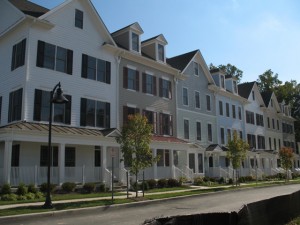
The rowhouses are arranged in long rectangular blocks, facing out onto comfortably narrow streets. Each unit displays slightly altered features, exchanging window treatments for a differently pitched roof, or a slightly longer porch for a bay window. Some are nicely painted, producing comfortable street views and further differentiating the buildings to the casual glance. Ornament is limited, sticking to the ordinary white trim of developments these days. Two central blocks contain larger houses with elegant but tiny porches nestled in gaps in the streetwall. These units are a little more homogenous than the others, yet they seem to more sophisticated and more appropriate to the site. They cut up space more, the porches thrust a well-proportioned mass out that still has an airy complexity. They have a nice rhythm, but they’re still all the same, staggered against the curve of Linden Lane to fit the site.
The dreary convention is a tragedy in the deeper context. The Seminary building is a complex agglomeration of buildings, articulated to emphasize continuity. One building flows into another casually, inflected and unified with references to other masses and details, as though that’s just how you do it. What looks jarring reveals itself to have some backwards harmony, developed organically with an eye to function. Complex relationships between scales carry from one style to the next, so that clashing styles do somehow relate. Consequently, neither the unit nor ensemble seem to be the focus, rather, they are simply the consequence of one another. On the other hand, the standardized houses nearby strain to hide the ensemble but are so clearly part of a repeated form that each unit is dissonant to the other.
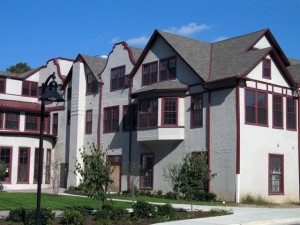
Their boxy, unitary forms are not enhanced by their bland wrappers. The neo-colonial detailing used for most houses does not capture a fragment of the delirious jumble of styles and their inventive interaction. For example, on one side of the old inn, Tudor roofs intermingle with Spanish colonial pediments, feathering the original building into the mission-style power plant. This blasé attitude toward good taste in the original buildings endures because it is a flexible response to a complex situation, while also bringing as little attention to itself as possible. In contrast, the adjacency of mission-style houses to the neo-colonial ones is painfully awkward, because they do not interrelate in any way, even though they are the same sheds prior to decoration. Each building was carefully designed to be inoffensive, yet they are also self-consciously unique. They bring attention to their minor differences, when their individuality is so thin that merely squinting reveals the repetition of window placements, hidden under slightly modified mullions and varied shutters.
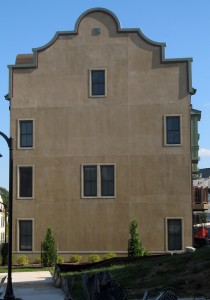
Still, even in cases when aesthetic approaches the right look, the height and proportion of the units makes them stand out as lanky and misshapen. It quickly becomes apparent that the only architectural reason for the varied heights of the white-framed porches arises from the degree to which engineers were able to bury the rear garages. On the narrow streets, the walls beneath them seem shear and intimidating. Off-the-shelf windows and cheap gutters only exacerbate the architectural flaws. No matter how nicely the watercolors in their pamphlets depict the houses, the awful quality of panelized construction grates against the hints of elegance.
And the master plan does not fail to disappoint my building prejudice. Rather than admit any other uses than family units, the planners have eliminated any retail or commercial use from the site. Instead, they have added a community center with a snack bar. Well then, why not a company store? When asked, the sales representative replies “Oh, don’t worry about that, there won’t be a 7-11 or anything like that,” Implying that commerce can only be crass and corporate. “What about a corner store?” The issue settles on her round face, “There is the Café in the Inn building.” The Communities of EYA apparently can’t tolerate even a food co-op.
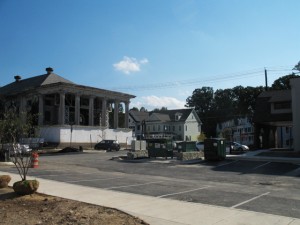
Perhaps more so, why are they not promoting one? In other projects they have placed street-frontage retail and grassy spaces, but not here, not in any way that draws people together. The relation of pedestrians in open spaces is equally uncomfortable. The high porches are too small for more than one person to sit comfortably and the shapely open spaces are given over to parking. To get to a real park, residents must pass through the old campus to the old gardens. Getting away from the area, one has to walk 30 minutes to get to any stores and the unpleasant journey to the Metro takes pedestrians over the din of the Beltway.
Nonetheless, it’s much better than conventional suburban developments in a metric of creating event. By event, I mean unplanned social exchanges, a substance of community. Now, the campus will inherently lend itself to event, due to adjacency and easy access to other families. It’s a small, isolated and culturally interesting site, that even has a few good tricks to pull people onto the street. Little mailbox blocks stand near the sidewalk, forcing individuals to get out of their houses to get the mail. It’s an innovative detail, one that will be interesting to study over time.
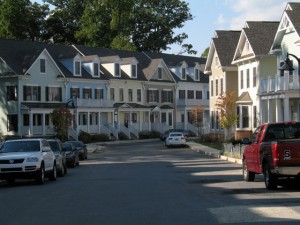
One afternoon in late September, some young professionals put out chairs on their lawn to enjoy the warm afternoon sun and a enough bottles of cold Coors Lite. The six couples admitted to not using their porches in the time that they had lived there but said that the closeness of the space let this kind of impromptu gathering happen all the time, something that is indeed harder in a conventional subdivision. It was a nice situation. Admittedly, the friends came to the area with an intact social network, but without the density, it would be more difficult to hang out as they were.
But again, the criticism is not that EYA’s work is terrible, just full of squandered opportunities. Except in the most extreme forms of separation and disruption, this casual association is just the ubiquitous activity of socializing. The houses are architecturally bland amid a sea of ideas. The good density is still a monoculture, but the neighborhood is still automobile dependent and still indistinct. There is no smaller grain of place, beyond the monumental Seminary, nothing contextual about the scene created by the new units. There is no interpretation of the context, no passing on of architectural content to be made original again with new uses.
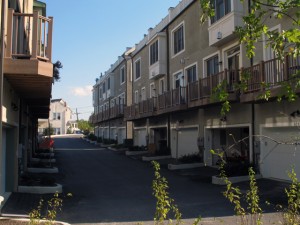
This website contains excellent resources. More photographs of the old buildings are available at my Flickr account. The complex doesn’t lend itself to photographs, you just might want to visit.
Monday, Part 1: Into the Woods;
Friday, Part 3: An Unintentional Project;
Sunday, Part 4: Back to the City.
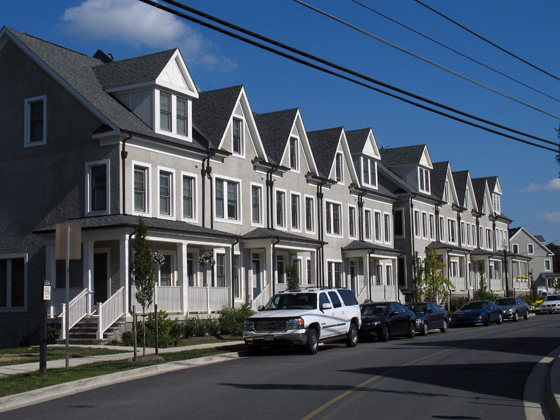
2 thoughts on “Forest Glen Seminary: One Thing Leads to Another”